Deeper into the Jungle
6 October, 2007, 05:40 pm in "Peru"
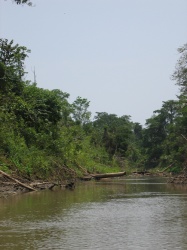 We weren't on the Ukayali very long: just a little upriver and across into a tributary. Making it up the tributary was difficult because the water was so low. Occasionally we hit mud or a submerged tree.
We weren't on the Ukayali very long: just a little upriver and across into a tributary. Making it up the tributary was difficult because the water was so low. Occasionally we hit mud or a submerged tree.The tributary wasn't as busy as the canal but it still had a fair number of boats. It looks like there is a bit of logging going on. Hopefully it is sustainable. Individual workers take their dugouts to an area, hike out into the forest and then cut certain trees and then pile the lumber by the shore. We also saw several fish traps and nets and fishermen. Next to the river are occasional structures with thatched roofs or the more basic, 4 wooden poles with a tarp over them.
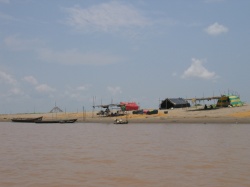
We see a lot of kingfishers, hawks and jacanas. One bird we saw while we were hiking in the jungle has the ability to imitate the calls of other birds. Some tribes believe feeding the brain of this bird to children will make them grow up to be smart. We also saw a couple very large green iguanas.
We had a lunch stop at a house by the river and our cook made fried chicken, plantains and rice over a fire covered with a grate.
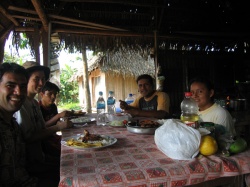
Rowshan dug up some clay from the bank and sculpted some pieces.
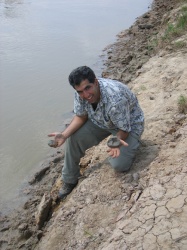
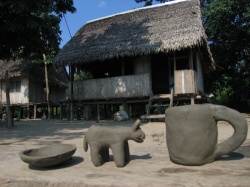
The people of the house were mostly relaxing. When we had arrived, they had been shelling a pile of dried beans by pounding the shells with a piece of wood then separating the red beans from the husks.
I was dismayed to see all the trash around the houses. I guess the attitude is when the river rises it will just sweep everything a way.
We got back into the boat and continued down the tributary. At a fork, Lalo asked an old man camped there which branch had more caymans. The man said the smaller one to the left.
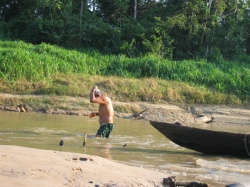
Eventually we reached the area we'd be camping. There was a cleared space and 4 wooden poles for a tarp. We had tents and mattresses. Rowshan made a pit kiln for his ceramics then we went on a short walk while water was being boiled for tea. We saw a beautiful blue butterfly flying about in the darkening forest. Then the sun set. Lalo said that since it is the dry season there are no mosquitoes. That must have been a relative term. As the sun set they began swarming. We had to rush to the tent and get our bug net hats. Even then we could hear them and the rest of our bodies were still targets.
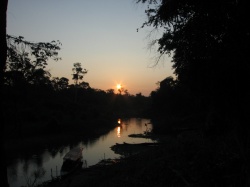
As it got darker, we went back to the boat with flashlights to search for caymans. We followed the tributary, shining our lights trying to catch the light in the caymans' eyes which would reflect red. We saw one but it disappeared before we got close. We followed the tributary until it became impassable then drifted back. On the way we spotted a group of red glowing eyes. The boat got close to one but it slipped under the water as we reached it. As we were discussing caymans, Lalo said the heads, along with the head of the anaconda were believed to bring money. This was because it was believed that cayman and anaconda can hypnotize their prey and attract them to where they can be caught. Rowshan said it was probably true the heads attracted money but only because people saw them, were curious and went into the store.
Back at the campsite, we jumped into our tents trying to escape the mosquitoes. The tent was full of them so we had to spend the next hour trying to kill them all. This was a challenge since we just had the light of a couple flash lights and mosquitoes don't smash very well against the sides of a tent. Swatting them with clothing and clapping them between our hands, we finally managed to get the tent mostly mosquito free (plugging the holes in the tent helped some). Even then, we could still hear the swarms outside the tent buzzing.
In the morning, the mosquitoes were still outside the tent but since we could see them we had a fighting chance. We took a morning walk looking for monkeys but didn't find any.
Back in the boat we headed back up the tributary and stopped at the house where we'd eaten the day before. While Tane cooked a very early lunch, Lalo took us for a walk to look for horned screamers.
On the way we crossed a field and ate berries from the Mujaka plant. The berries grow inside a flower which looks like a lantern. Lalo said the root is good for treating Dengue fever.
The lake was a marsh with no water in sight, though plenty of water plants revealing where the water was. The horned screamers are big black birds with white bellies and speckles on their necks. They make loud noises that sound like dogs or seals barking which can be heard from quite far.
We walked out to what had once been the lake edge and watched them fly into the trees. All around were lush green plants and swarms of butterflies and dragonflies. This is what is beautiful about the jungle, the abundance of life (though I could do without the mosquitoes).
Back at the house, Rowshan gave a little girl the clay dog he had made. She seemed unsure what to do with it. Rowshan pretended it barked and growled which scared the girl and made her cry. So he made it play football instead and patched things up.
Rowshan noticed a small wasp's nest which Lalo said belonged to poisonous shiro shiro wasps. Earlier, from the boat we had seen a huge bell wasp nest a couple feet long high up in tree. Lalo also pointed out the swelda plant which grows on other trees and is thought to be good for healing fractures if it grows on a lemon or orange tree which have strong wood.
As we got closer to the river, there was practically a traffic jam of boats moving slowly onward. Some perpetually had to be bailed and were loaded heavily with lumber. The end channel we were on had only been 3 meters a few years ago but the water from the Ukayali had opened it up to be 30 meters.
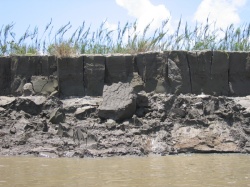
It must be so strange living in a place with such impermanence: canals coming and going, entire villages having to move, the river changing its path...
We crossed the river and found a group of dolphins. The dolphins are frightened of the boats. Fishermen illegally poach the dolphins because people pay a lot for the sexual organs because they believe they will help men be better at attracting women. Lalo said they had found several dead dolphins on the beaches with these parts taken out. The dolphin we found near Trujillo was most likely another victim of this belief since the only injury I'd noticed was a slit on its underside.
We cut the engine and watched the dolphins surfacing. Sometimes they'd swim under the boat leaving a trail of bubbles on the surface. We were headed back to the canal when there was a flash, a whack, and a splash. A fish had jumped out of the water and whacked Rowshan in the arm. There was a slimy fish shaped spot on his sleeve.
By the time we got back to the lodge we were quite ready to get off the boat. We spent the evening relaxing and finally saw the sunset over the lake.
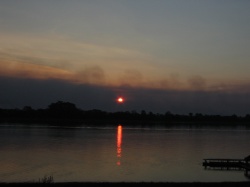
Mr. Hanky, the toilet toad is still there.
Comments
- Comments
Powered by My Blog 1.69. Copyright 2003-2006 FuzzyMonkey.net.
Created by the scripting wizards at FuzzyMonkey.net..
(Code modified by Rowshan Dowlatabadi)
Created by the scripting wizards at FuzzyMonkey.net..
(Code modified by Rowshan Dowlatabadi)

